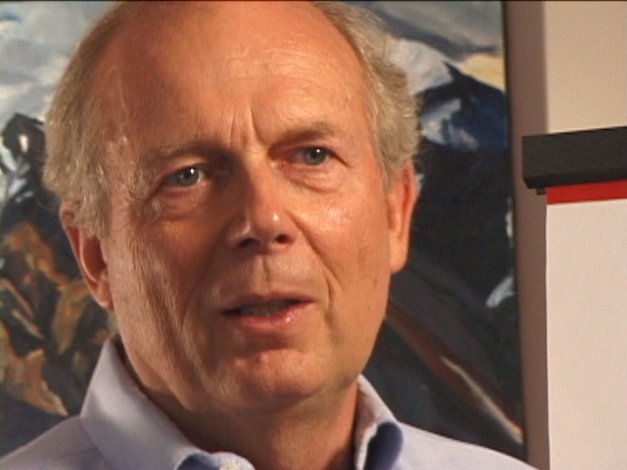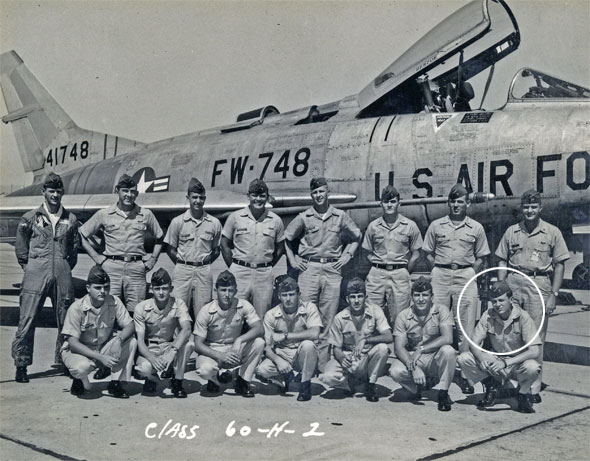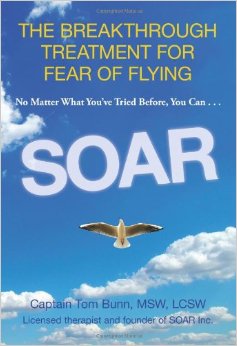Pursuit: Founder and President of SOAR, treatment in fear of flying.
Definition of success: Succeeding where others have failed – see below!
Even if you’re not afraid of flying, there’s a good chance you know someone who is. Reports suggest around one in every five of us suffers from aviophobia, and if you’re one of them you’ll know that sensation of sheer terror as you dig your nails into the armrests every time the plane drops or wobbles. Help is at hand of course: short of knocking yourself out before take off, there are hundreds of courses on offer which claim to alleviate – and in the most ambitious instances, completely overcome – your anxiety of stepping onto an airliner. But do they really work? Pilot of the USA’s first operational supersonic jet, captain with Pan Am and United, and founder of SOAR (Seminars On Aeroanxiety Relief) Captain Tom Bunn MSW, LCSW believes he has hit on the one and only method that truly does what it says on the tin: overcomes that seemingly insurmountable fear of taking to the skies. Established way back in 1982, longevity alone would suggest success, but how did SOAR come about?
“There was a pilot at Pan Am,” Tom says, “and in 1975 he put together a course and he asked me to work with him. This was around 1980 and I told him I didn’t have any interest in being around a bunch of crazy people who were afraid of flying. He said, ‘Ah come take a look – you’ll be surprised.’ And I found it interesting that they were all very intelligent – because they could think of thousands of things that could go wrong, and they were very imaginative because they could put each of them in their mind so vividly that it drove them nuts. And when I saw what great people he was working with I got kind of hooked on it. Then the problem became: how to improve a course that was very basic – it was new, it was innovative, but it didn’t work very well; it worked for some people but mostly it didn’t So the next ten years was spent trying to find a method that would work and that’s where we got to the oxytocin. But it took about ten years, so during this time I was still flying, first for Pan Am and then United, then retired, so I’ve been doing this full time since retirement.”
Hang on a minute – oxytocin? I don’t want to wander off topic here, but there’s science behind SOAR, and to understand Tom’s commitment and what led him to his own success, I think I need an oxytocin 101:
“There’s a part of the brain called the Amygdala,” Tom explains. “It’s just a Greek word for almond, and it refers to a cluster of brain cells – roughly the size and shape of an almond. Now, it sits right behind the eye, so it gets information from the eye, raw – straight from the eye. So it can react to – let’s say you’re walking in the woods and there’s a snake there – it can react in eighteen thousandths of a second, whereas without the Amygdala it would take you at least a tenth of a second to process that vision. So the Amygdala’s got some really good things it does for us: it uses stress hormones. But on the airplane it’s a problem because every time the plane drops it releases stress hormones, so in turbulence you get stress hormone release, stress hormone release – it drives you up the wall. There’s a hormone called oxytocin which will shut down the Amygdala. Now why would nature set this up? Well, interestingly enough nature cares a lot about reproduction, so in the broad sense of reproduction there are certain situations where oxytocin is released. And oxytocin goes to the Amygdala and says ‘hey buddy, take a nap.’ Ok, the situation in human life that produces the most oxytocin is nursing a child. But oxytocin is also produced in how you get a child. When the sexual chemistry is good between two people the female – not so much male – but the female gets oxytocin to shut down her fear of what you want to do to her. (Guys, interestingly enough, don’t get so much oxytocin!) It’s a little x-rated, but we can look for a moment that produces oxytocin. For example: there’s your lover lying there right next to you after you’ve made love and she’s holding a photograph, by her face, of the door of the plane closing. The Amygdala will believe anything, so we link together the closing of the door on the airplane with sexual afterglow. What we do then is link thirty or forty different things that are going to happen on the plane, so that as the flight unfolds and each time one of those things happens that could produce stress hormones, oxytocin is starting to shut down the Amygdala system.”
Who would have thought treatment for aviophobia could get so steamy? Regardless, SOAR has its roots firmly embedded in the world of science. You won’t find the deep breathing, group therapy exercises so favoured by the airlines in any of SOAR’s courses. With such an atypical approach, can there possibly be a typical ‘day in the life’ for Captain Tom? Actually, yes…
“It is pretty typical,” Tom asserts. “People set up times to do a counselling session. I spend – depending on which programme they’re in – at least half an hour with them and what we’re doing is saying, ‘Ok look, let’s find that moment that brings oxytocin to you,’ and then we link flying to it. With ordinary therapy you want to be face to face with the person, because you want the client to link to you, to your face, but in this case I’m trying to link the client to the face of their lover or the face of their friend, the person who’s trustworthy. So it works ok to do it by phone. I do it literally all over the world with people so on an average day I’m working with two, three, four people on fine tuning, how they set up this exercise that trains the mind to not produce the stress hormones. And then, when I have left over time I’m writing blogs or articles for Psychology Today or getting onto Twitter and Facebook and other social media.”
Once again, I notice a leaning towards helping others, or at least influencing them for the good. And I wonder if, as The Secrets of their Success progresses, we’re going to see this theme develop, this inclination towards selflessness. I ask Tom what part of his role gives him the most satisfaction:
“Satisfaction is really having developed something that works far better than any other training that deals with fear of flying. To be talking to people who have tried everything else and got nowhere, and finally convince them that they should try this. And then hearing back from them a few weeks later that they got on a flight expecting it not work – they kept waiting for the panic to happen and it didn’t happen, and now they’re thinking, ‘This is very confusing, how come when I have busted my butt trying to control these feelings, I’m now getting on the plane and they’re okay?’ And so people call back and they’re just amazed and delighted. And it opens up the whole world to them. That’s pretty satisfying.”
Perhaps it stems from a military background, but Tom seems to have arranged SOAR into such a neatly organised package that he can slot it into a fairly regular working day:
“I spend probably eight hours a day on this, so it’s a pretty normal amount of work. Back in 1986 – I remember, because that was when I moved from Pan Am to United – I did everything: I did the business side of it and I did the counselling side; the production of the course. So it was just a one-man operation. Then as it grew, then it made sense for my partner Lisa to be involved. Because she’s taken over the business side of it, I’ve been able to put more time into the promotion and the development. At the time that she came on broad, the course was on audio cassette, and then we went to video and that’s made a big difference: instead of two courses a week it’s two courses a day. There’ll be calls from people who are saying, ‘Gee I found your website or your number – is this something that could possibly work for me?’”
Tom has appeared regularly on such channels as Fox, CNN and NBC to name but a few –sufficient exposure to propel him to the leagues of those who’ve ‘made it’ in life. But what does success mean to him?
“Well if you go back to the Pan Am course, that the other pilot put together, it depended on education, exposure to an airplane, breathing and relaxation exercises, and then we would take them at the end of the course on a flight. So there the people were, on the flight, doing the exercises to relax themselves, but in a state of panic – it was not working. So success for me was: how do we fix this problem, where people are using breathing exercises and relaxation exercises, still in a state of panic?”
So Tom equates success to resolving a problem where others have failed?
“They’ve failed at it, but they do not agree that they’ve failed at it. The situation is that we have found a way to stop the release of stress hormones, and regulate stress hormones, that works completely unconsciously.”
Testimonials suggest Tom has hit the Eureka moment when it comes to treatment for fear of flying, and his understanding of aviophobia seems to have paved the way to his achievements. It hasn’t always been smooth flying though. Take heed, success-seekers:
“You’re going to have to follow where you see the evidence taking you, even though everybody else might say, ‘What the hell are you doing?’ And that’s when you feel really very alone; you see right now, I know that this works, but the prominent system in psychology is cognitive behavioural therapy, and there are literally hundreds of thousands of cognitive therapists who are invested in their training and their practices, who will insist they can treat the fear of flying, which is a lie. Maybe they don’t know it, maybe they think they can do it, but when they don’t succeed they just blame the client. But when I talk on some of the forums on psychology about what could be done to deal with fear of flying, it sometimes causes a firestorm. When you’ve got hundreds of people firing at you, and you’re standing alone – this is what you’ve gotta be able to deal with if you’re going to do this kind of thing.”
As with all my guests, I’d like to thank Captain Tom Bunn for taking the time to talk to me. We got to discuss a lot of the deeper theories of success and why some are more readily drawn to it than others, but in the name of a nice succinct piece, I have saved these nuggets for discussion in the ‘definitions of success’ area. (Don’t worry Tom, I promise not to claim any of your wisdom as my own!) So keep an eye out there – more to come soon..
You can follow Tom @flightwit and if you’re an aviophobia sufferer help can be found at: https://www.fearofflying.com/
There’s a great little interview with Tom and one of his satisfied clients talking to NBC’s Roseanne Colletti here: https://www.nbcnewyork.com/on-air/as-seen-on/229298821.html
Finally, Tom’s best-selling book ‘SOAR: The Breakthrough Treatment for Fear of Flying’ is available on Amazon: goo.gl/znkTlp



